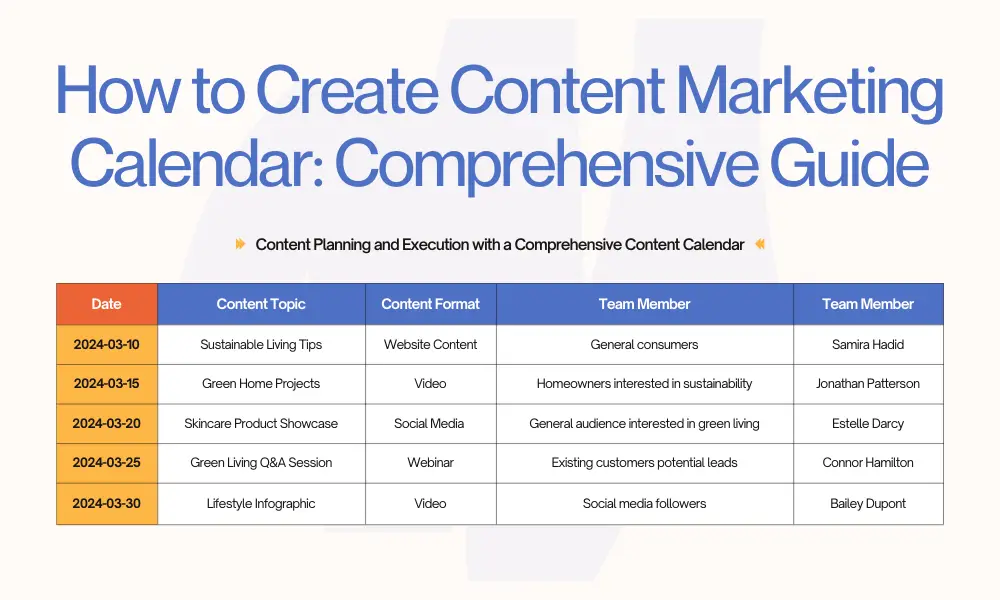Do you want to learn how to create a content marketing calendar? You’re in the right place.
A content marketing calendar is essential for organizations, businesses, or content creators looking to organize, schedule, and manage their content strategy effectively.
It not only helps streamline content creation and publishing but also aligns content goals with business objectives, ensuring that your marketing efforts remain consistent, timely, and audience-centric.
Following topics will be covered in this post:
- Why You Need a Content Marketing Calendar
- Step-by-Step Guide to Creating a Content Marketing Calendar
- Sample Content Calendar Template
- Final Tips for a Successful Content Calendar
RELATED
- Best Content Marketing Tools for Beginners
- Content Marketing Mistakes to Avoid: A Comprehensive Guide
- Why Does it Take So Long to Get Traffic on New Blogs, Even With Good Content, and SEO?
- Analytics Advantage: Driving Social Media Success with Data Insights
- How to Optimize for “Near Me” Searches for Local Services
|| Looking for amazing responsive themes starting from $2? Find Here. Looking for a fast-performance web-hosting? Get Here.
01. Why You Need a Content Marketing Calendar
A content marketing calendar enables you to:
- Stay organized: Track deadlines, avoid last-minute scrambles, and plan content months in advance.
- Ensure consistency: Consistent publishing builds audience trust and drives engagement.
- Align with marketing goals: Helps keep content aligned with seasonal trends, promotional events, and key objectives.
- Measure effectiveness: Track content performance and iterate based on what works best.
02. Step-by-Step Guide to Creating a Content Marketing Calendar
Follow these steps to create a content marketing calendar.
Step 1: Set Clear Goals and KPIs
Start by defining the objectives of your content marketing efforts. This will guide the type of content you create, the platforms you use, and the metrics you track.
Common content marketing goals include:
- Increasing brand awareness
- Driving website traffic
- Generating leads or sales
- Engaging and retaining customers
Establish KPIs (Key Performance Indicators) such as web traffic, engagement rates, lead conversions, or sales. Clear goals help shape your calendar and make tracking performance easier.
Step 2: Identify Your Target Audience
Understand who your content is for by developing a detailed buyer persona.
A strong persona includes:
- Demographics: Age, gender, location, income
- Psychographics: Interests, lifestyle, values
- Pain points: Specific problems they face that your content can help solve
Knowing your audience will help you select the right topics, channels, and content formats, ensuring your calendar remains relevant and effective.
Step 3: Choose Content Types and Formats
Variety keeps your audience engaged, so consider a mix of content types, such as:
- Blog posts for in-depth information and SEO benefits
- Social media posts for immediate engagement and sharing
- Email newsletters for nurturing leads
- Videos to engage and explain complex ideas visually
- Webinars for live engagement and industry authority
Different formats work best on different channels, so choose what best fits your target audience’s preferences and your goals.
Step 4: Conduct Topic and Keyword Research
Conduct research to identify high-impact topics relevant to your audience.
Here are some effective methods:
- Use keyword research tools like Google Keyword Planner, Mangools SEO Tools, or Ahrefs to discover terms with high search volume.
- Analyze competitors to find gaps or topics where you can add unique value.
- Review your own analytics to find popular content that can be expanded upon or updated.
Make a list of primary and secondary keywords to guide each content piece and improve your SEO.
Step 5: Develop a Posting Schedule
Determine the frequency of your posts based on your goals, available resources, and audience engagement trends.
A typical posting frequency might look like this:
- Blog posts: 2-4 times per month
- Social media posts: Daily or multiple times per week
- Email newsletters: Bi-weekly or monthly
- Videos/webinars: Monthly or quarterly, depending on production capacity
Consistency is key, so balance frequency with quality and resources.
Step 6: Select Tools for Your Calendar
Many tools are available to help you create and maintain your content marketing calendar, including:
- Trello or Asana: Great for managing tasks, setting deadlines, and tracking progress.
- Google Calendar or Excel: Simple and customizable, great for small teams or solo creators.
- Specialized platforms: Tools like CoSchedule or Hootsuite offer advanced features for scheduling, tracking analytics, and even automating social media posts.
Choose a tool that suits your team’s workflow and offers flexibility as your needs evolve.
Step 7: Outline the Calendar Content and Assign Roles
A content marketing calendar should include details about each planned piece of content, such as:
- Content type (e.g., blog post, video, infographic)
- Topic/Title
- Primary keywords
- Target audience segment
- Publishing date
- Platform(s) for distribution
- Assigned team members responsible for creation, editing, and publishing
Assign clear roles to each team member to avoid confusion and ensure accountability.
Step 8: Create a Workflow for Content Creation and Publishing
Your calendar should include an established workflow. This helps streamline content creation and maintain consistency.
A typical workflow might look like this:
- Ideation: Brainstorm and finalize topics.
- Research: Conduct thorough research on the topic.
- Writing and Editing: Draft and edit the content.
- Design: Create visuals or other media.
- Publishing: Schedule and publish the content.
- Promotion: Share across social media and email lists.
- Measurement: Track performance and record key insights.
This process ensures that each piece of content is well-researched, engaging, and aligned with your brand’s standards.
Step 9: Plan Seasonal and Evergreen Content
To keep your calendar dynamic, include a mix of seasonal (time-sensitive) and evergreen (always relevant) content.
- Seasonal content: Align with holidays, industry events, or important dates for your audience.
- Evergreen content: Covers topics that remain relevant over time and attract traffic consistently.
An ideal calendar may have a 60-70% evergreen to 30-40% seasonal content ratio to ensure stability and adaptability.
Related: How to Repurpose Content for Different Platforms
Step 10: Regularly Review and Adjust the Calendar
Content marketing is dynamic, and so is your calendar. Regularly assess your content’s performance and make adjustments based on what resonates with your audience.
Key metrics to review include:
- Engagement rates: How are people interacting with your content?
- Traffic sources: Which channels are most effective?
- Conversion rates: How many leads or sales are generated?
Monthly or quarterly reviews will allow you to adapt your strategy based on data-driven insights.
03. Sample Content Calendar Template
Here’s a basic structure for a content calendar:
| Date | Content Type | Topic/Title | Keywords | Target Audience | Platform | Assigned To | Status |
|---|---|---|---|---|---|---|---|
| Jan 10, 20XX | Blog Post | 5 Tips for Effective Remote Work | remote work tips | Working professionals | Blog | Sarah | Draft |
| Jan 15, 20XX | Social Media | Quote Graphic | N/A | General Audience | Design Team | Scheduled | |
| Jan 20, 20XX | January Newsletter | monthly highlights | Subscribers | Marketing | Ready |
This template can be expanded based on your specific needs and team roles.
04. Final Tips for a Successful Content Calendar
Here are some final tips for a successful content calendar:
- Stay flexible: Marketing trends and audience preferences can change quickly, so be prepared to adjust your calendar.
- Leverage analytics: Regularly review analytics to inform future content.
- Communicate with your team: Keep communication open to ensure everyone understands the goals and timelines.
- Repurpose content: Use high-performing content across different channels to maximize its reach.
A well-maintained content marketing calendar is more than a schedule; it’s a strategic tool for delivering valuable, engaging, and timely content to your audience. By following these steps, you’ll be able to create and maintain an effective content marketing calendar that drives your organization toward its marketing goals.
Also Read
- 9 Proven Tips to Optimize Instagram Store for More Customers
- A Complete Guide to Understanding Instagram Insights | Analytics Evolution
- How OCR Transforms Images into Editable Content
- Local SEO Tips for Photographers: Boost Visibility & Attract Clients
- Using Google My Business for Small Businesses | Guide
- How to Optimize Your Blog for Voice Search
- Voice Search Trends 2025 and Beyond






Leave a Reply